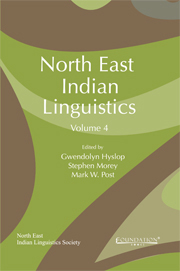Book contents
- Frontmatter
- Contents
- About the Contributors
- Foreword
- A Note from the Editors
- History, Contact and Evolution
- 1 On the Origins of Bodo-Garo
- 2 The Stammbaum of Boro-Garo
- 3 Variation in the Order of Modification in Tai Ahom: An Indication of Historical Boro-Garo Influence?
- 4 The Nominalizing Velar Prefix *gV- in Tibeto-Burman Languages of Northeast India
- Bodo-Garo Grammar
- Orthography, Poetics and Text
- New Descriptions
- Classifiers
- Eastern Indo-Aryan Grammar
- Austroasiatic
2 - The Stammbaum of Boro-Garo
from History, Contact and Evolution
Published online by Cambridge University Press: 05 May 2013
- Frontmatter
- Contents
- About the Contributors
- Foreword
- A Note from the Editors
- History, Contact and Evolution
- 1 On the Origins of Bodo-Garo
- 2 The Stammbaum of Boro-Garo
- 3 Variation in the Order of Modification in Tai Ahom: An Indication of Historical Boro-Garo Influence?
- 4 The Nominalizing Velar Prefix *gV- in Tibeto-Burman Languages of Northeast India
- Bodo-Garo Grammar
- Orthography, Poetics and Text
- New Descriptions
- Classifiers
- Eastern Indo-Aryan Grammar
- Austroasiatic
Summary
Background
The membership of the Boro-Garo branch of Tibeto-Burman has been clear, at least since the 1903 publication of Vol. III, No. II of George Grierson's Linguistic Survey of India. This volume was devoted to the “Bodo, Nāgā, & Kachin” languages and it included a map, “Bodo Group,” that is still the best map of these languages that I know. This map is reproduced here as Figure 1, but with the modern names for the languages added. Even the subgrouping within the Boro-Garo branch has received a wide consensus, although this has more often been due to copying previous guesses, than any serious new inspection of the data (Burling 1983, Egerod 1980, Hale 1982, Shafer 1966–74). Enough new data on these languages has now become available to invite a fresh consideration of their relationship.
The languages that are presumed to belong to the Boro-Garo group are listed across the bottom of Figure 2, and the forks in this diagram summarize my best present judgment about how the various languages are related to one other. The forks are numbered roughly from the top to the bottom of the diagram, and they represent splits between smaller groups within Boro-Garo. After describing some features that are characteristics of most or all of the Boro-Garo languages, I will point to the evidence that supports each of these splits.
- Type
- Chapter
- Information
- North East Indian Linguistics , pp. 21 - 35Publisher: Foundation BooksPrint publication year: 2012



